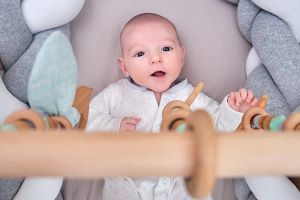 A new study published in the Journal of Child Development looked at infant exuberant object play at home.
A new study published in the Journal of Child Development looked at infant exuberant object play at home.
“Researchers have long considered play to be a primary context of infant learning,” study author Catherine Tamis-LeMonda told us. “However, studies of play are confined to laboratory tasks. Our study is about how infants interact with objects spontaneously at home. We wanted to know how much infants interacted with objects outside from the laboratory confines, with the objects that they typically have access to in their everyday environments. Specifically we aimed to document the time spent with objects, how infants distribute that time over extended periods of time, and which objects they engage with.”
The researchers had predictions about differences among age groups (maybe would increase with age) and between same-aged crawlers and walkers (walkers maybe would access more variety of objects). However, given the lack of prior data and theorizing about infant natural object activity in the home, this study was exploratory and descriptive. That is, no study to date has simply documented what babies do at home. And, due to those limitations, the researchers assumed that infants should “sit still with a new toy and play for many minutes at a time”, applying expectations for school-age children to infants (inappropriately).
“In the past, most studies that looked at infant object interactions were done in brief laboratory sessions with novel toys,” Tamis-LeMonda told us. “We wanted to know how infants interacted with objects in their natural everyday environments when they were free to choose, or not, any object available to them. This would allow us to speak to parents about what babies do and to alleviate concerns of parents that (1) they need to buy all the latest gadgets and toys for infants; and (2) infants should be showing prolonged time with objects, etc.”
The researchers wanted to know how infants interacted with objects in their everyday environments. They did come in with the idea that varied experiences are critical during the period of infancy when everything is new and babies are learning about objects, object functions, and what they can do with the things around them. They recorded infants in their home, going about their day, without intrusion for four hours. Then they scored each time infants manipulated an object and classified the type of object that they interacted with.
“Infants interact with objects in very short bouts that add up,” Tamis-LeMonda told us. “We were surprised that infants’ interactions with an object or set of objects in a play bout lasts only around ten seconds! However, those dozens and dozens of bursts of activity add up. On average infants spend 60% of their time awake interacting with all sorts of objects that they have at home.”
Even when toys are designed to attract children’s interest, with bright colors and sounds, infants do not show a preference toward toys. Infants play with all objects that they find in their home—pillows, remote controls, cabinet doors, empty boxes, and so on. Every object is a potential play object. And they play with objects all the time.
“We knew that infants interacted with objects, but we didn’t expect (1) bouts to be so brief; (2) infants to interact with so many objects; (3) infants to accumulate so much time with objects; and (4) infants to spend EQUAL time with toys and non-toys, even in homes where toys are everywhere,” Tamis-LeMonda told us. “We didn’t know infants would engage with household objects as much as they did.”
The study is a great beginning to start to understand how much infants interact with objects in their natural environment. However, infants in the study came from mostly white, upper-middleclass, educated families living in New York area. Researchers still need to understand if infants living in areas with less access to toys or from different cultures interact the same amount with objects. And what the researchers are seeing suggests the characteristics of infant play that they have documented generalize to other cultures, including places where toys are rare. Also, mothers’ involvement and routines are factors that could affect object interactions and the functional use of objects. Further studies should look at what children are doing when they are interacting with objects.
“Our findings identify the everyday inputs to infants’ natural learning with objects,” Tamis-LeMonda told us. “Infants’ exuberant activity may provide an ideal curriculum for learning about the properties and functions of objects. Infants learn about the objects that surround them by playing with all types of objects, in short bursts of activity, that accumulate to an enormous amounts of practice. In giving advice to parents we’d say: (1) Don’t drive yourself crazy buying new toys for infants—everything is a play object, so just let them play safely; (2) Do not worry if your infant flits from object to object and does not spend lots of time with a single object or toy. This is normal and adaptive. It is not a liability, and (3) use play as an opportunity to join in and name objects and so on, as babies learn the words for the objects they are engaged with and the things they are doing.”
Patricia Tomasi is a mom, maternal mental health advocate, journalist, and speaker. She writes regularly for the Huffington Post Canada, focusing primarily on maternal mental health after suffering from severe postpartum anxiety twice. You can find her Huffington Post biography here. Patricia is also a Patient Expert Advisor for the North American-based, Maternal Mental Health Research Collective and is the founder of the online peer support group - Facebook Postpartum Depression & Anxiety Support Group - with over 1500 members worldwide. Blog: www.patriciatomasiblog.wordpress.com
Email: tomasi.patricia@gmail.com